For centuries there was production of millstones in these mountains, now a national park. The production in Kvernfjellet (The millstone mountains) started sometime during the 1500s, and lasted until 1914. There have been many sites for millstone productions in Norway during history, but this was the biggest with more than 1000 quarries. For some centuries this area supplied more or less all the country with these stones. In the 1800s most of the bread eaten in Noway was baked from flour made with thes stones, that is mica-schist scattered with 2-5mm large crystals of hard minerals. In the picture above is a broken millstone left in the mountains.
Millstones were needed to grind grain, our most important food source, in Norway as in so many countries. There have been a lot of scientific work on these sites lately. A multidisiplinary research project involving geologists, archaelogists, historians, botanists, geographers and people with craft knowledge. Also cooperations with researchers in other contries, like Denmark, UK and Spain. The objective is to study the long forgotten cultural and industrial landscape of millstone production.
The old house in the picture above, Kvernfjellstoggo, was moved from the mountains to the village of Selbu about 100 years ago. It is now part of the village museum, and local historian John O. Evjen is showing one of the bigger millstones.
The mills were always by a stream, so that the mills could be run be hydro power directly, like this old mill. One of many in this area.
There are quarries all over Norway, small or big, and used at different times. The different communities are now cooperating to make this important part of history known. On the picture above is Franziska Rüttimann (to the right), who is the new leader of the national center for millstones, Norsk Kvernsteinsenter. It is located in Hyllestad in Western Norway, and they cooperate with the other millstone regions. On the picture above she is shown the millstone exhibition of Selbu Bygdemuseum, by Solveig Borseth.
This is a house from the millstone mountains. 10 men used to spend the winter in a house like this, coocking, sleeping, resting, in one small room. They were all farmers, and had to spend the summer in the village, farming the land and producing food for the cattle and the people. And all winter it was hard work cutting stones. Many of them died on their way to or from the mountains, as it was high mountains and blizzards were common. Most norwegians today probably have no idea how hard the life was just a hundred years ago. There are more photos in this gallery.
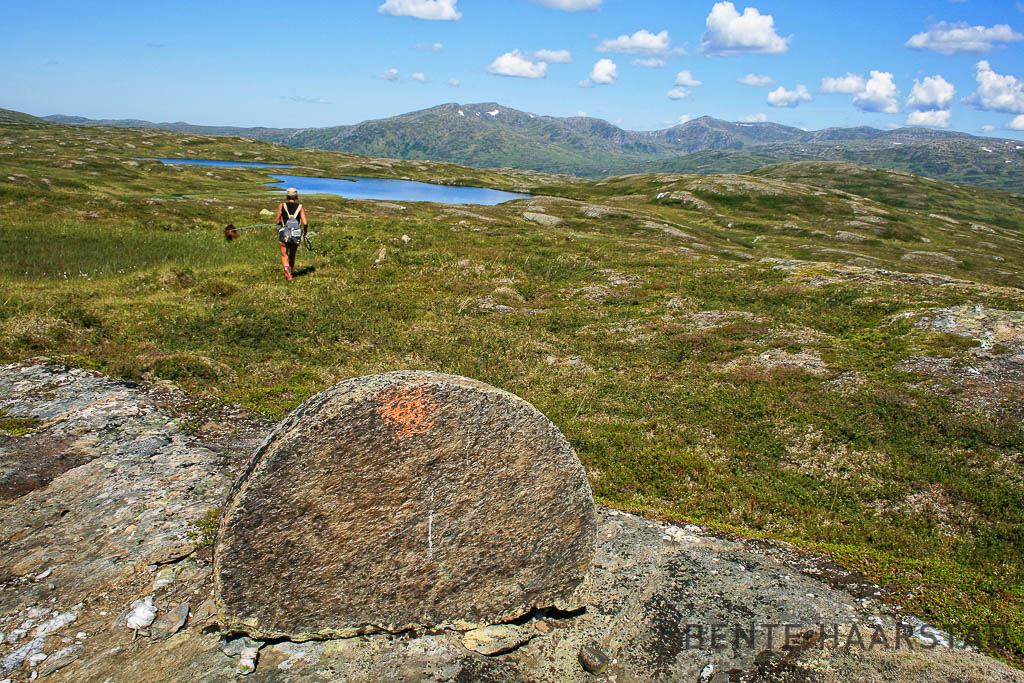
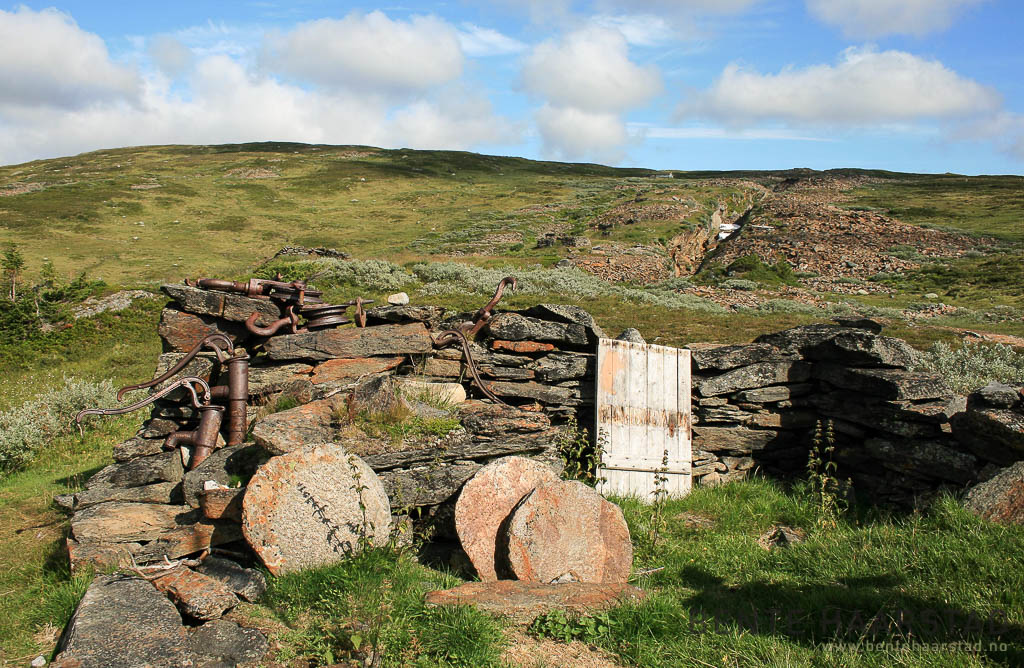

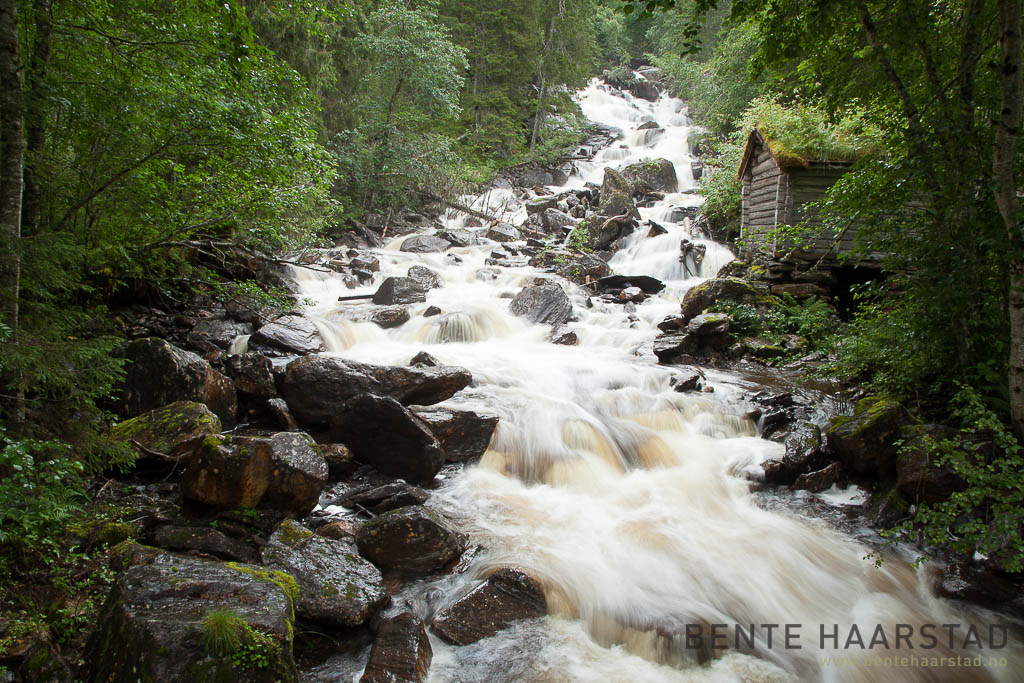
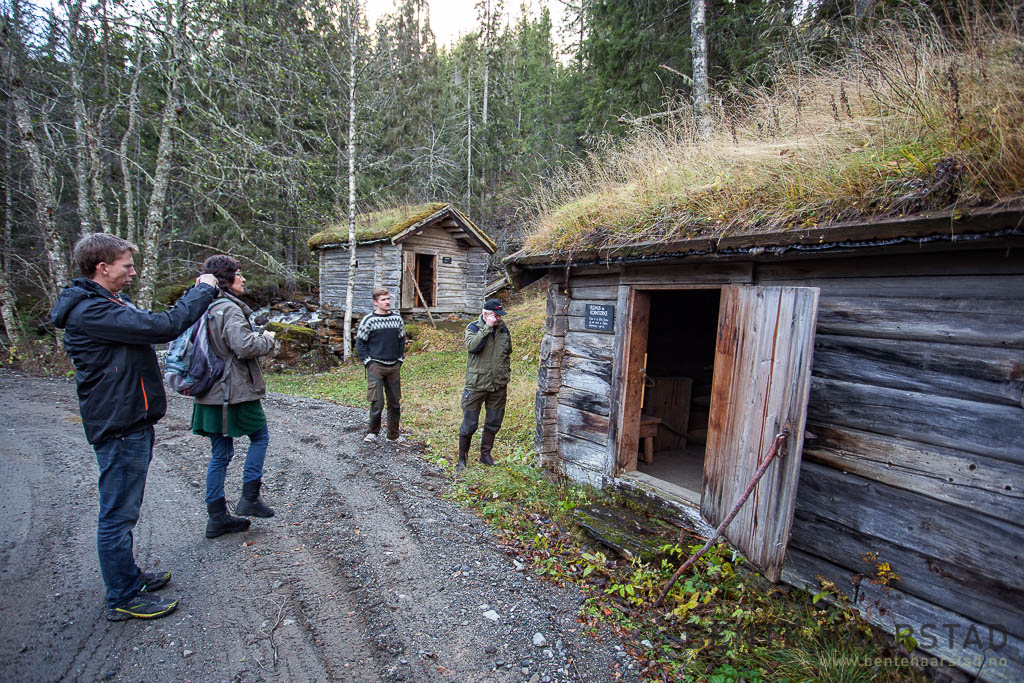
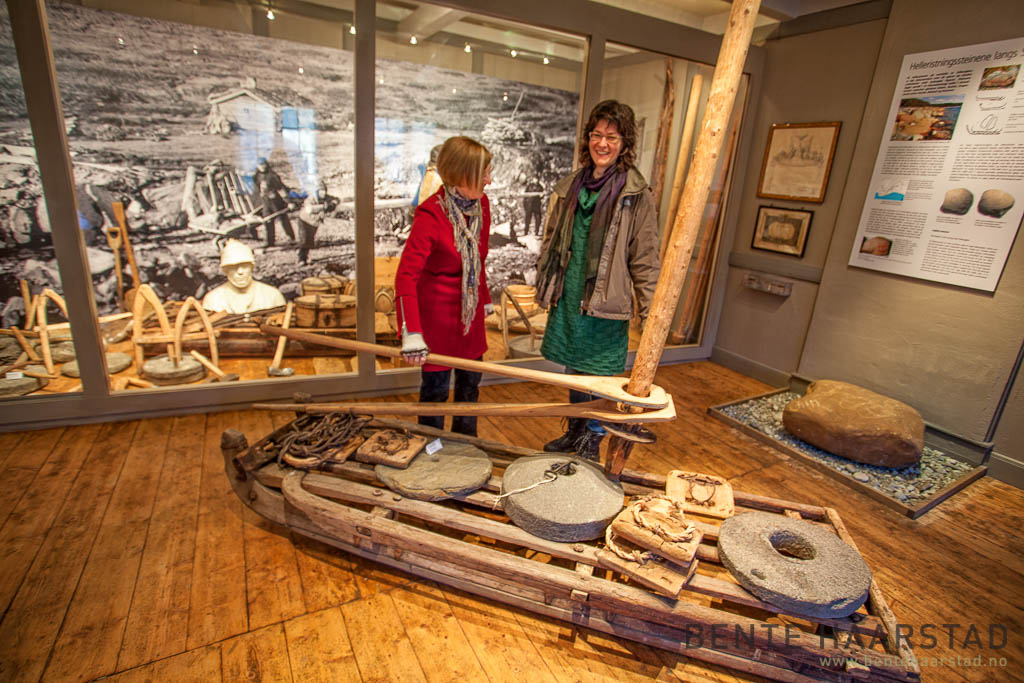


Such big millstones !!! Thank you for giving the details surrounding them …feels like reliving a small part of history 🙂
LikeLiked by 2 people
Yes, the biggest millstones are quite big, and it was long and hard work to make them, and to transport them. First down from the mountains with horses in the spring, and then out to the “world”. Thank you for your comment, Ady.
LikeLiked by 3 people
I saw one of these in Spain many years ago. It was amazing to think of the grain it must have ground over the years.
LikeLiked by 2 people
Used for centuries, Anneli, and different ones in so many countries. In Norway they were used mainly for grinding rye and oats, they were important in our diet then. Wheat does not grow that well here and is now imported.
LikeLiked by 1 person
These are such beautiful objects, and what a wonderful history. Your photos have given me such a taste to visit Norway.
LikeLiked by 1 person
These stones are part of our history, that is for sure. But kind of forgotten I guess, since we now just walk to to shop and buy some bread, anytime. It is the old Norway you see on the pictures, but I hope we can preserve some of our roots and history. You are welcome, Anna.
LikeLiked by 1 person
Interesting report Bente.
European culture was based on the hard grain, wheat which need to be ground.
And the mechanical solution and the way of thinking said have made a direction
of western technological development.
Though, eastern culture was based on the rice which can be eaten just by boiling
said have made the east technically rugged behind. (A theory said.)
LikeLiked by 1 person
As a cold northern country with only 1 percent arable land the old Norwegian could only dream about wheat bread, Yoshi. Rye and oats were our staple food, and they are even harder to grind than wheat. Maybe that is why the stones are so big? Interesting to hear the difference compared to rice: it was easier for you to get food. But I don’t think I follow you concerning the east tecnically rugged behind. At least not with the technology invented these days. Thanks for your comment Yoshi.
LikeLike
Lovely images and very interesting history.
LikeLiked by 1 person
Thank you Gunta. I am glad you liked them.
LikeLike
Fascinating history but what incredibly hard work. Love the green roof.
LikeLiked by 2 people
Yes, incredibly hard work. The green roofs were all over the place before. We still have some around. Thank you Gallivanta.
LikeLiked by 1 person
I’m sad that, here in America, given the fads of ‘low carbohydrates’ ‘ gluten-free’ diet, so many people eschew the beauty, history and tradition of grain based cultures – I purchase my red winter wheat from a local farmer who still plants his fields with the seed ‘descendents’ of the seed his great-grandfather used – unfortunately – I use an electric mill to grind, because the only ‘stone ground’ mills available for purchase for use in a home are way out of my budget -! 🙂 Thank you for the beautiful and informative post!
LikeLiked by 2 people
I agree with you. I believe all these fad diets is not the solution for a healthy diet or slimmer bodies. Just look at our forefathers and foremothers, they certainly looks slim enough, so we probably have something to learn from their frugal diet. Not all is as lucky as you who can get seed with well known origin. And interesting to know about the small mills still in use, electric or stone. In the museum I also saw small stone mills, every home (farm) had one of those before, to make grains for porrigde. I didn’t know. Or didn’t think about it. Thank you TamrahJo.
LikeLiked by 1 person
Awesome post and photos.
LikeLike
Thank you Emilio.
LikeLike
It is really incredible for me.
LikeLiked by 1 person
These ecomuseums keep us in touch with the not too distant past but serve to make us consider how life has changed in such a short time. Fascinating post. Amelia
LikeLiked by 1 person
Changed, that is the world. It is strange to think how modest lives people lived around here just 100 years ago. Thanks Amelia.
LikeLiked by 1 person
Fascinating post Bente! Beautifil images!
LikeLiked by 1 person
Thank you very much Adrian.
LikeLike
Lovely documentary/landscape images as always Bente, especially the portrait of Mr Evjen.
LikeLiked by 1 person
You should have heard Mr. Evjen talking. He really knows his local history, and how to tell about it. Thank you very much Rudolf.
LikeLike
Fantastic history, nice shots as usual !
LikeLike
Thank you very much Croquedessin.
LikeLike
Great images, Bente. We have millstones like these in our own Peak District National Park, in fact a millstone is the symbol for the park.
LikeLike
How interesting. Does it mean they were made there, or used at the stream there? Thank you for your comment Elveden.
LikeLike
Both – the stones were made from local gritstone, a hard sandstone, and used the power of the streams in the hills to grind wheat for flour.
LikeLiked by 1 person
Så underbara bilder. Längtar till Norrland får nog bli en resa till , kanske till sommaren
LikeLike
Ja, de nordlige delene av Norge og Sverige er fine, interessante områder. Tusen takk for din kommentar 0504jojo.
LikeLike
Imagining the long winter evenings and nights cutting stones … what stories they must have exchanged .
Lovely post and pictures Bente .
LikeLiked by 1 person
And what stories they must have lived. Compared with their lives we are all spoilt these days. Thank you very much Poppy.
LikeLiked by 1 person
Fantastic photos and very interesting to read, thanks Bente!
LikeLike
Thank you very much Ann.
LikeLiked by 1 person
Interessant reportasje med vakre bilder, Bente!
LikeLike
Snilt av deg, Dina, tusen takk.
LikeLike
This is the most interesting story Bente! I would like to reblog it for my friends to read about the history of stones for food in Norway and to indulge in your stunning photographs..
LikeLike
Yes you can, Dor. And thanks a lot.
LikeLike
Reblogged this on Virginia Views and commented:
A beautiful departure from Virginia Views!
LikeLiked by 2 people
Hello Bente,
A very interesting report. I love herbal roof.
Good day to you.
Val
LikeLike
Thank you Val. And I like the old houses with grass on the roof too. They still make roofs like this sometimes.
LikeLike
Thank you so much for this special report, Bente! Fascinating!
LikeLike
Thank you Amy.
LikeLike
I love the sod house! that is a gorgeous and peaceful photo
LikeLiked by 1 person
Now I have googled “sod house”, and yes I like them too. Strange thing is that is how people lived not that long ago. Thank you Nancy.
LikeLike
Helt underbara bilder! Är mkt intresserad av “hur man gjorde då” dessutom 🙂 Min mormor tvättade t ex kläder i en fjällbäck till 1968…
Kram och allt gott till dej!
LikeLike
Vasket klær i fjellbekken helt til 1968, oj, det er imponerende, og må ha vært kaldt og hardt arbeid. Brrrr. Ikke så overrasket, på gården til mine besteforeldre var det bare toalett ute (utedo) fram til først på 1970-tallet. Det har skjedd utrolig mye de siste tiårene. Mye til det bedre, men ikke alt. Tusen takk, og klem til deg også Svorskan.
LikeLike
Reportage très intéressant et magnifiques photos . Merci pour ce partage
LikeLiked by 1 person
Merci de ta visite Pierrette.
LikeLike
Simply stunning pastorals and glimpses back in time~
LikeLike
Thank you very much Cindy.
LikeLike
This is fascinating, Bente.
LikeLiked by 1 person
Thank you very much Diana.
LikeLike
Thanks for all the interesting information and the great photo’s of the stones Bente
LikeLike
Thanks for your kind words Natuurfreak.
LikeLike
Very different in the desert! Grain was ground on a hollowed out stone called a metate. It was ground by hand with a round stone tool. On a larger scale, the grinding stones we set outside and a horse was hooked up to the stone on top. He walked round and round making the top stone go around and grind the meal. Wish I had photos! Yours were great.
LikeLike
This is an interesting story all of the world it seems. Our common history, with all the varieties. Where people have been eating grains of some kind. But I was told (thanks Yoshizen) that in Asian countries where rice was the staple food, they did not have to grind. Rice just have to boil! Thank, interesting comment Emilie.
LikeLike
Mills always fascinated me, and your story too!!! 🙂
LikeLike
I agree, mills are fascinating. Thank you Claudine.
LikeLike
Superb photos.
Thanks for sharing this aspect of Norwegian life – that winter one-roomed cottage is amazing. We certainly have it easy in modern times.
LikeLike
Easy and comfortable all the time, Vicki. Many of us, but not all. That room and this history made me think too, how things have changed in such a short time. Thank you.
LikeLike
Fascinating!
LikeLike
Glad you liked it Montucky.
LikeLike
Absolutely gorgeous, and completely fascinating! I’ve seen a few large ones here in the American South — but never in person, in situ! (Only in museums sadly….)
LikeLike
Yes, most of them are in museums these days I suppose. Except in this village. The millstones are all over the place – used as outdoor tables, as steps before a building, just decorations, or left in the mountains. And some are still in old mills, but not for daily use. I love to hear all the millstone stories from around the world. Also the museum stories. Thank you Fey Girld.
LikeLike
Your photos and narrative are wonderful, Bente. There were grist mills in my home state of Iowa in the 1800s, before corn and oats supplanted wheat as a primary crop. I have visited this mill, but clearly mills were far more important in your country. There was a popular American song called “Down by the Old Mill Stream,” that my dad used to sing to my mother when they were courting.
LikeLike
How interesting Shoreacres. I am sure the were some bread-eaters in Iowa too back in the 1800s. Seems like it from the song. And interesting to hear about the change to corn and oats. Thank you.
LikeLike
These last facts are astonishing, about the ten farmers… only a hundred years ago! Interesting blog with beautiful photo s.
LikeLike
Thanks for sharing some Norwegian history. Reminds me of the millstones found in New England – USA which are not as old of course used mostly for grinding corn.
LikeLike
that is superb 🙂
LikeLike
Really interesting as ever and I like your new fomat ! Very visually effective.
LikeLike
Thanks Bente. Delighted to have found your intriguing and eye catching blog. Loved this window into the past – so easy for us in comfortable modernity to forget the enormous labour of everyday life experienced by the generations before us who gave us so much. Great to have that heritage illustrated so beautifully here. Regards from Thom at the immortal jukebox.
LikeLike
What a wonderful history of the millstone in Norway, and beautiful photographs, Bente. Just beautiful!
LikeLike
Beautiful pictures of a beautiful country. I like to read about the history of your country. We spent twice our holiday in Norway en we certainly come back! Such a beautiful nature!
LikeLiked by 1 person
Love all your National Park posts!
LikeLike
Loved this!
LikeLike
That’s beautiful!
LikeLike
Stunning pictures,d that provide a focus for meditation
LikeLike
Very interesting. I really enjoyed this post!
LikeLike
On related topic… across half a world away: http://en.m.wikipedia.org/wiki/Panchakki
LikeLike
I like this post
LikeLiked by 1 person
So many beautiful scenes Bente! We also have millstones in our part of ancient Devon on the edge of Dartmoor. A fascinating, and timeless process.
LikeLike
Some of the finest pictures i have seen so far
LikeLike
Great photos and story. Reblogging on Nutsrok
LikeLike
Reblogged this on Nutsrok and commented:
Beautiful post from Bente Haarstad Photography.
LikeLike
Reblogged this on TwisterReed's Blog and commented:
…Better to have a millstone around your neck… The Bible
LikeLike
Very interesting story abour Norway and life back then. Enjoyed the photography too.
LikeLike
Absolutely beautiful!
LikeLike
Those are some huge stones. It is good that they have been kept for future generations to see where they came from.
LikeLike
It is always humbling to see how those that came before were able to flourish, and how much more work their day to day activities were than what we take for granted today. Thank you for sharing!
LikeLiked by 1 person
Reblogged this on The Fenn Diagrams.
LikeLike
So interesting and lovely photos!
LikeLike
Fascinating, but most of all I love the photos, great stuff!
LikeLike
Congratulations for being Freshly Pressed, Bente! You really deserve it as your photos in this post really bring up that curiosity in me, and your readers I believe.
LikeLike
Reblogged this on saserejoshua's Blog.
LikeLike
Reblogged this on Nomadic Journey and commented:
That looks so peaceful
LikeLike
The stones are speaking of a life long past yet so full of the rich history of Norway. My husband’s ancestors came from Norway and this is such a wonderful post. Your images are stunning especially of the waterfall. Gorgeous. Congratulations on being Freshly Pressed, a well-deserved recognition.
LikeLike
Is that what they mean by “stone soup!?”
LikeLike
According to the nutritionist Adele Davis, when modern milling methods replaced stones in the late 19th century, mental illness rose dramatically. Seems a lot of essential vitamins are ground away or destroyed by heat in power grinding. The stone ground flour was much healthier, and bread made from the flour was far more nutritious.
LikeLike
A fascinating series of photos and back story Bente! Congratulations on being Freshly Pressed! 🙂
LikeLike
Excellent photo essay – the waterfall is beautiful. And the millstones are curiously beautiful as well.
LikeLike
Very nice pictures
LikeLike
Reblogged this on cheffixit.
LikeLike
Interesting!
LikeLike
Just beautiful ❤
LikeLike
Stopped by your Blog, and glad that I did. I just love snooping around in Historical places. There are quite a number of places around my area. One of them is the Berks County History Center where they do have on display Mill Stones that were once used to grind corn into flower. It was all done by hand. There was no fancy machinery back then.
Be Well
Les
LikeLike
Reblogged this on a flying aspidistra and commented:
Really interesting – travel and history combined. Makes me want to put Norway on my list of places to visit. That is, when I get over my fear of flying…..
LikeLike
That’s not food. Stones are not food. They hurt my teeth and sound like anguish. The end.
LikeLike
Wonderful historical images – really informative.
LikeLike
Looks cool. It would be neat to see in person.
LikeLike
Reblogged this on tolmima.
LikeLiked by 1 person
Great reading about millstones. My family history includes lots of millers in heartland of the USA and this article hits home!
LikeLike
Superb images and a great piece of history, thanks for the insights.
LikeLike
What gorgeous photos of Norway! Amazing how things have changed–this was a wonderful peak into the past.
LikeLike
Something we hardly think of when we open a packet of flour today. Interesting photos thank you for sharing.
LikeLike
Great set!!!
LikeLike
Reblogged this on Suraya Khatun: Breeze on my neck.
LikeLike
it’s a great idea to bring up forgotten history, especially related to staple needs like food production. never knew the equipment was that big to make bread in the past. a great choice of subject and wonderful pics!
LikeLike
Thanks for sharing, Bente. It realy puts into perspective how far food production has come over the years, and what a wonderful place to visit. All the best, Emma
LikeLike
Pretty insightful. Thanks for sharing
LikeLike
Gratulerer med Freshly Pressed. Vel fortjent.
LikeLike
mus have food
LikeLike
The Millstone Mountains, how amazing, and what a fascinating piece of history. I love the photos of the giant old stones out in the grass, with lichen and moss growing on them. Really beautiful. Now we need a tour of the brown cheese factory 🙂
LikeLike
Beautiful pictures and what a different way of living. Very interesting!
LikeLike
To get meal you first have to grind the corn, think about that for a minute
LikeLike
What a history. Big milestones!
LikeLike
Wonderful photos. These round stones are telling us other tales of (hard) ordinary life.
LikeLike
Wow! Fantastic, it looks like an industrial scale!
LikeLike
Yes, it was on an industrial scale. Industry of that time, with manual work and hardship. Thank you Captian.
LikeLiked by 1 person